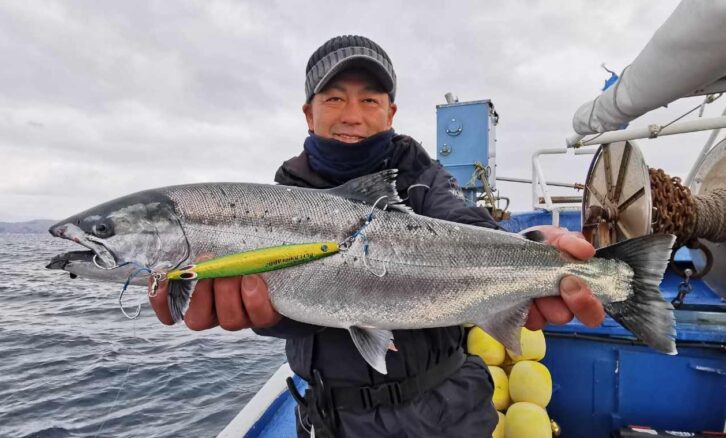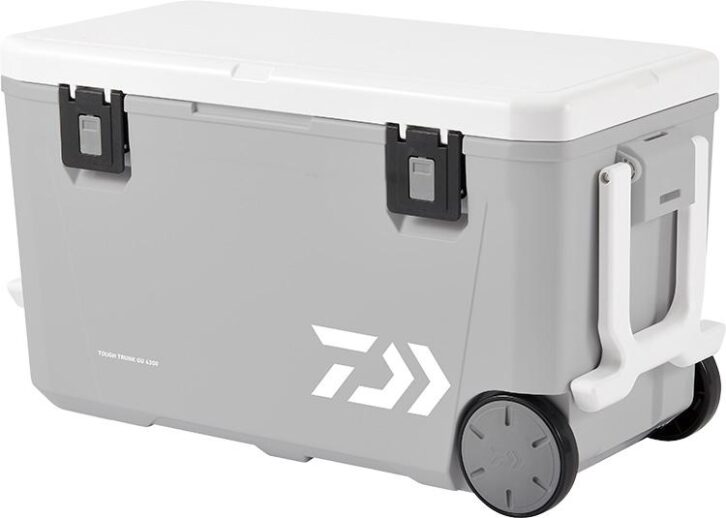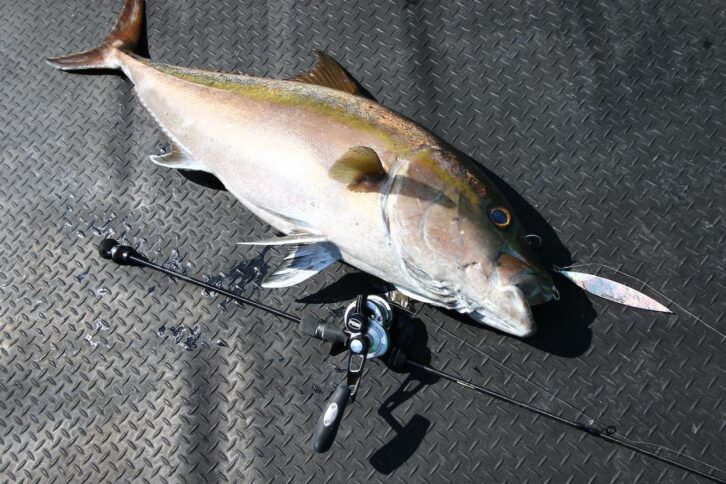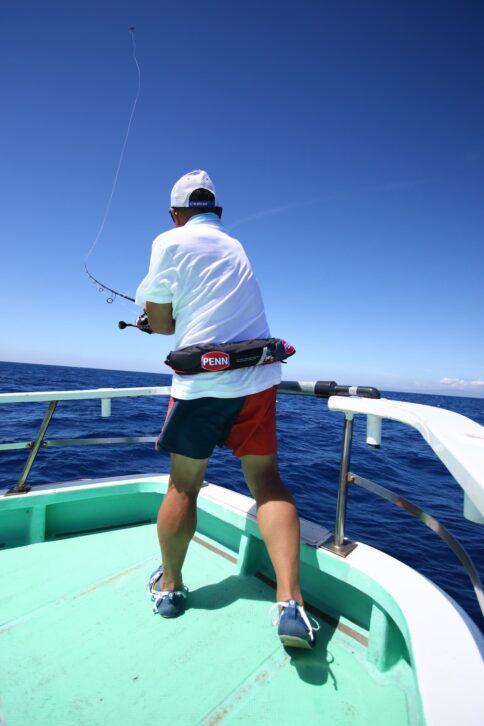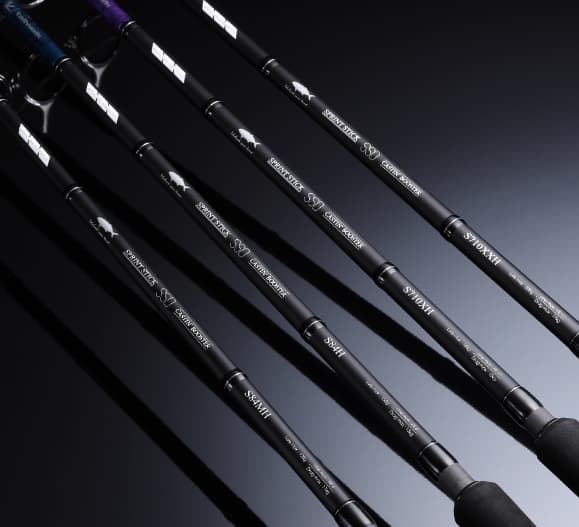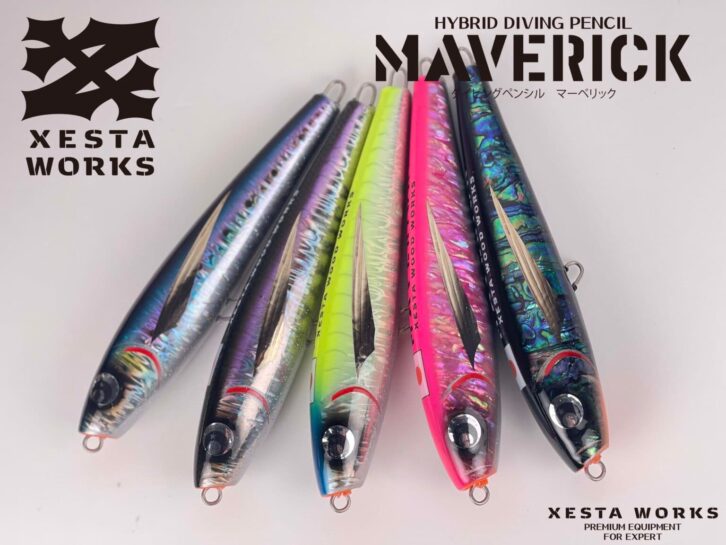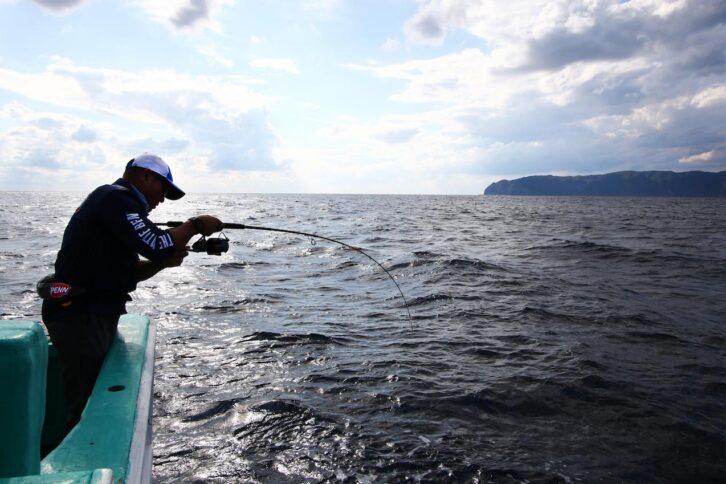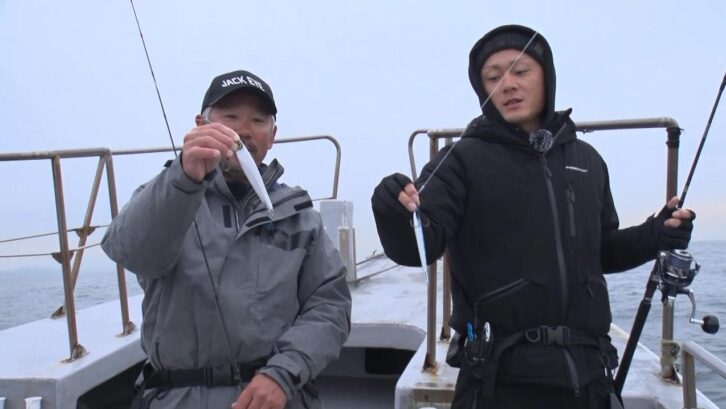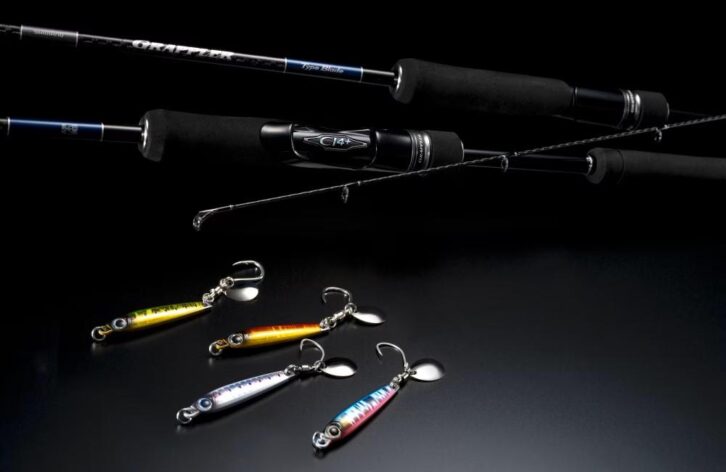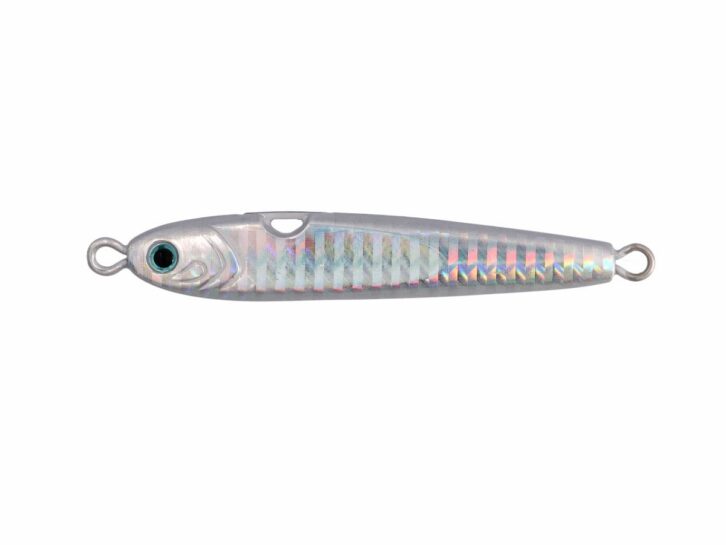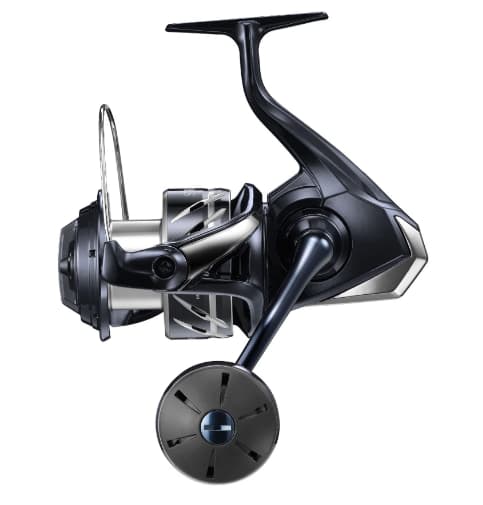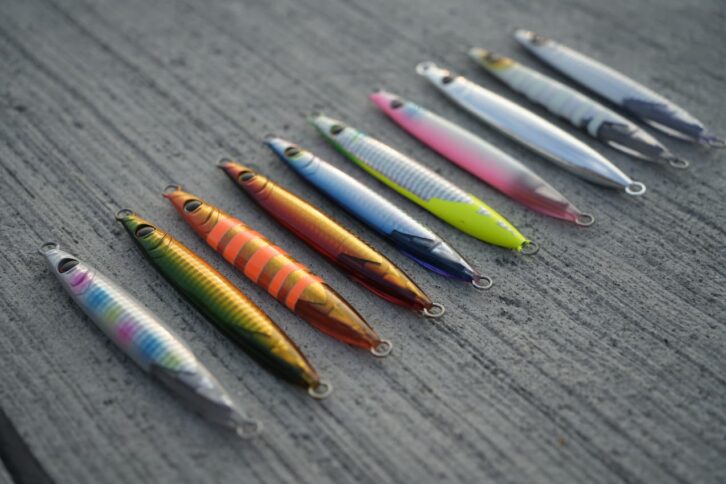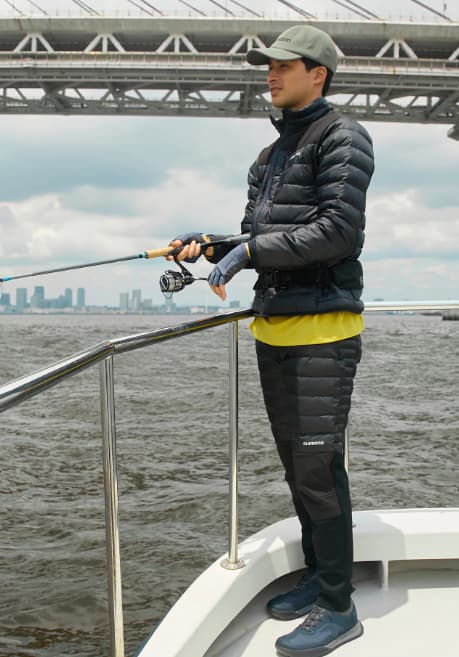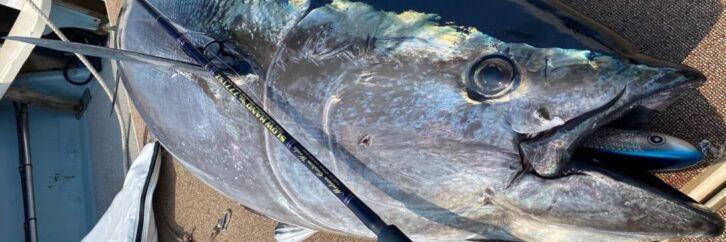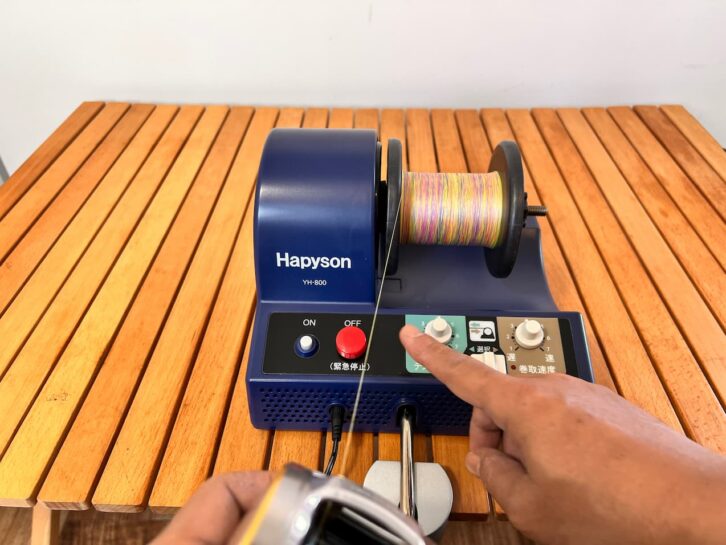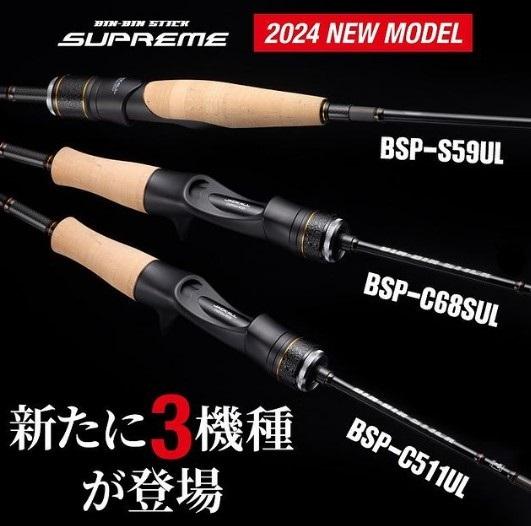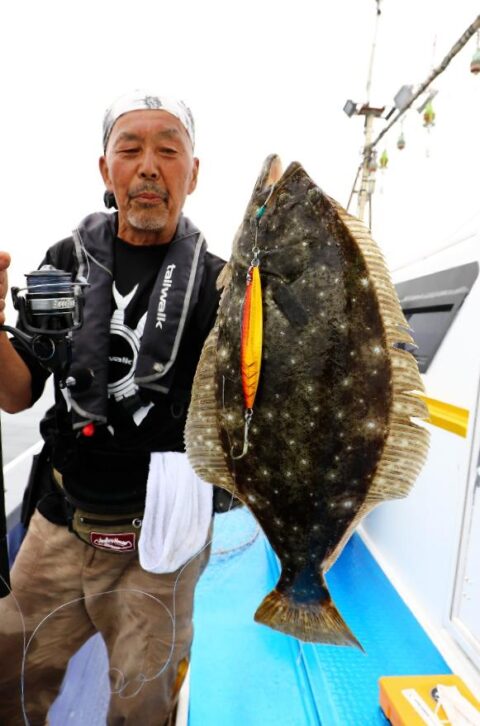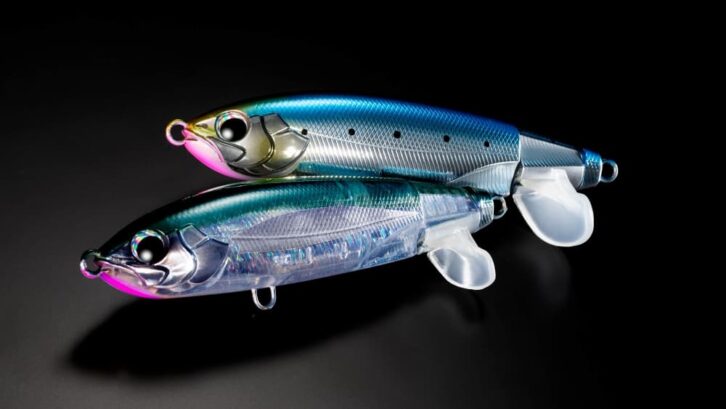arrived at based on numerous past results
Kei Hiramatsu x yellowtail amberjack method of fishing Jigging Jerk Patterns and Tackle
As reported in a recent Angler's Time article, Kei Hiramatsu (titles below) caught three good-sized yellowtail amberjack, including one over 20 kg, on a fishing trip to Tsushima in the spring of 2025. Hiramatsu's approach to jigging is to read the field, select the best lures from his own strategy, select jigs accordingly, decide how to move them, and lead the yellowtail amberjack to prey. In this article, I would like to explain Hiramatsu's basic jerk patterns and tackle.
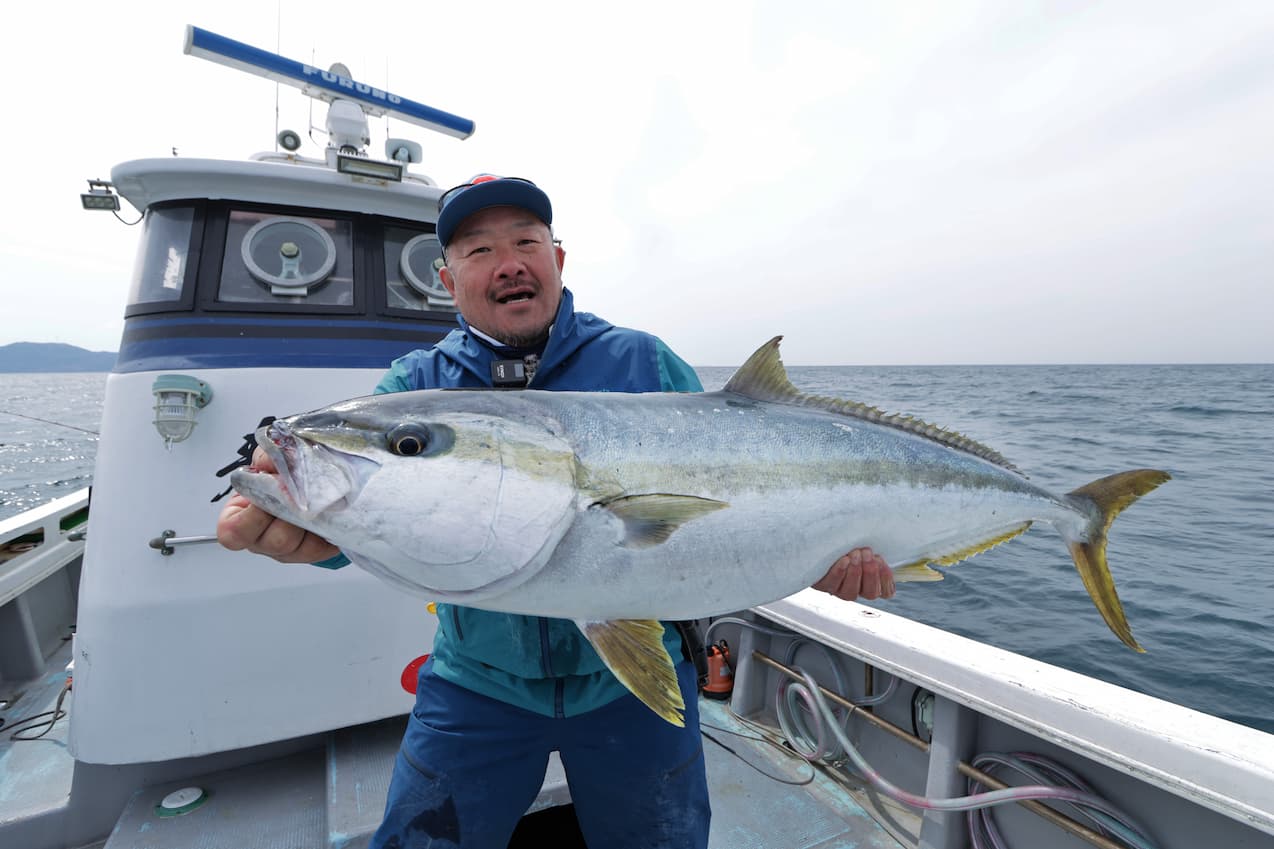
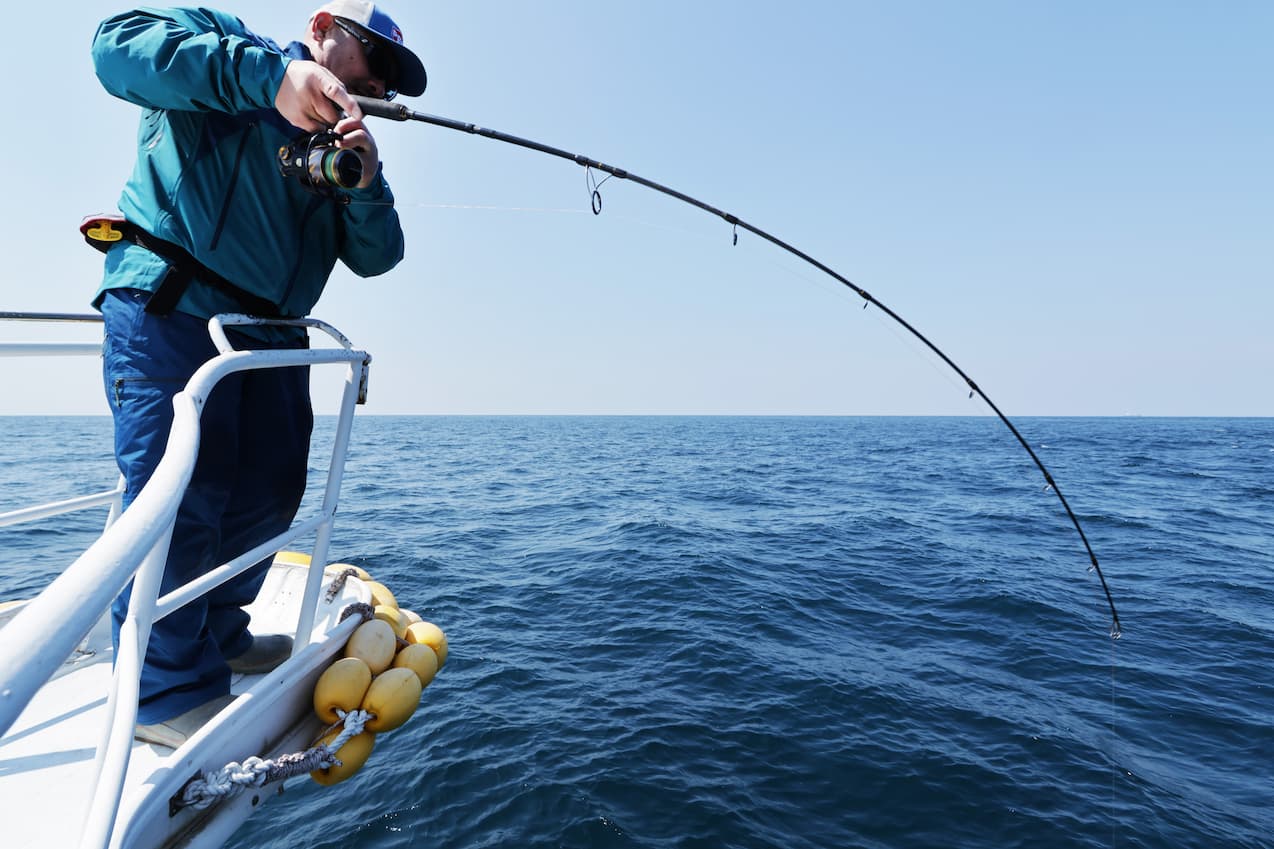
INDEX
Familiar Tackle and Its Performance
Kei Hiramatsu has been chasing yellowtail amberjack for many years. Since the early days of jigging, Kei Hiramatsu has had a special passion for sunfish, and he has been going to the field to the fullest, targeting yellowtail amberjack as his main target, and studying the techniques for catching them on his own. He has also developed the best tackle for his chosen strategies. During a single fishing trip to Tsushima in the spring of 2025, Hiramatsu caught a 20.17-kilogram kingfish, as well as a 15.5-kilogram and a 15.2-kilogram yellowtail amberjack, all by jigging. The fishing was mainly jigging with accompanying anglers on a tour for Goldic, Hiramatsu’s fishing tackle store, and filming for a supporting manufacturer, but Hiramatsu was the only angler who caught a good-sized fish over 15 kg. The catch was the result of a good reading of the field and a well-chosen strategy, and while casting for large spring sunfish may have caught the attention of many on social networking sites, jigging and consistently catching large fish is no easy task. Hiramatsu, however, has been successful.
Hiramatsu’s tackle for jigging for yellowtail amberjack is based on the question of how to move the jig to attract the sunfish. This is the basic principle. The main jigs he uses are the K-FLAT Gammy, Gammy fat, KEI Jig, KEI Jig Sharp, and KEI Jig S-cape, which he developed himself. There are two basic methods of luring yellowtail amberjack. One is “line movement” and the other is “point movement”.
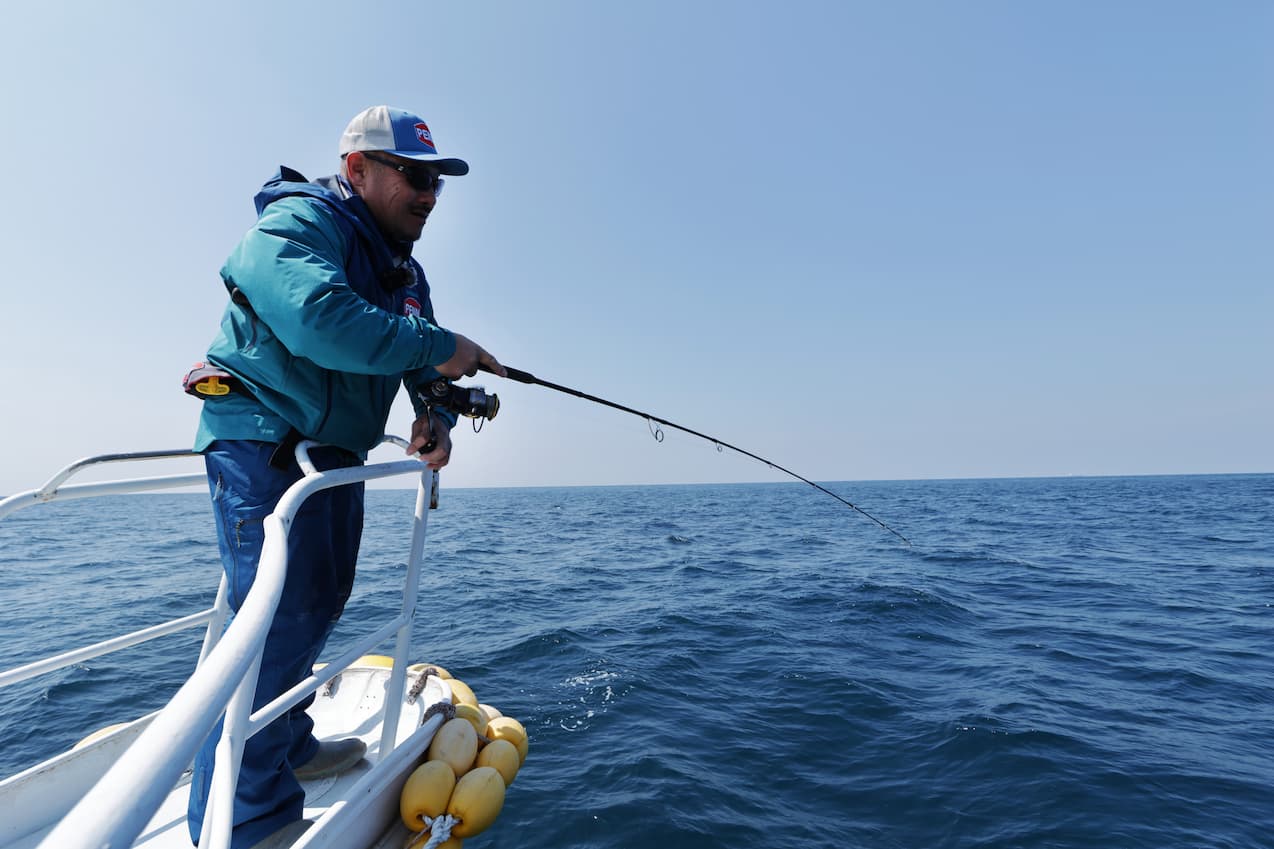
There are two basic jerk patterns. Lines and dots. And you need jigs and rods to ensure that you can perform that exploration.
“Line movements” that probe a wide range of bait reactions.
When the fish finder detects that the bait is responding widely from the bottom, or that the fish is chasing and feeding on the bait, Hiramatsu uses what he calls “line action” to probe widely. He passes the jig through the wide layer where the reaction is occurring while jerking. It is the same as using a plug to cast for yellowtail amberjack in areas where sunfish are migrating or where bait is present, and you can think of it as doing the same in the water. Incidentally, the jigs used in this line of operation are KEI Jig, KEI Jig Sharp, and KEI Jig S-cape.
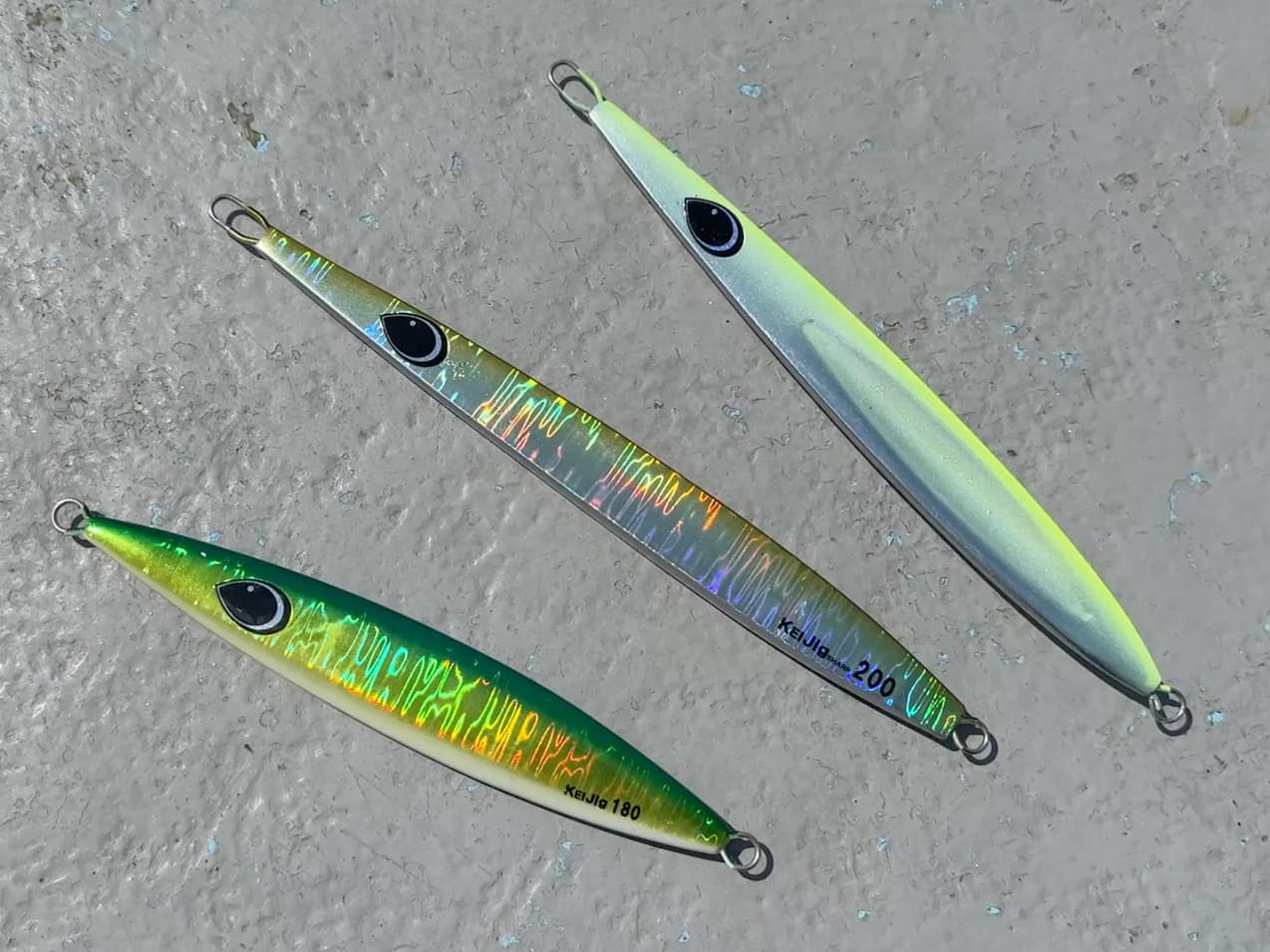
From the bottom, KEI Jig, KEI Jig Sharp, and KEI Jig S-cape.
The basic method of jerking is a one-pitch jerk. The jig is jerked for a long distance to make it chase and catch fish. Hiramatsu is conscious of keeping the jig moving at all times. This is to create the illusion of a fleeing bait. The yellowtail amberjack that have been chasing the jig will reverse when the jig stops. He uses rod movement to add intensity to the action, but basically he jerks the jig at a constant speed to create the movement of a bait that has left the school of bait and is being chased by a fish eater. Because of this, Hiramatsu’s one-pitch jerk involves constantly reeling in the reel and adding rod action. The one-pitch jerk includes a slow jerk in which the rod is reeled in as the angler sucks up the reel and the reel is not reeled in when the rod is lowered, but Hiramatsu’s jerk is a continuous motion like twitching a plug (although the rod action is reversed).
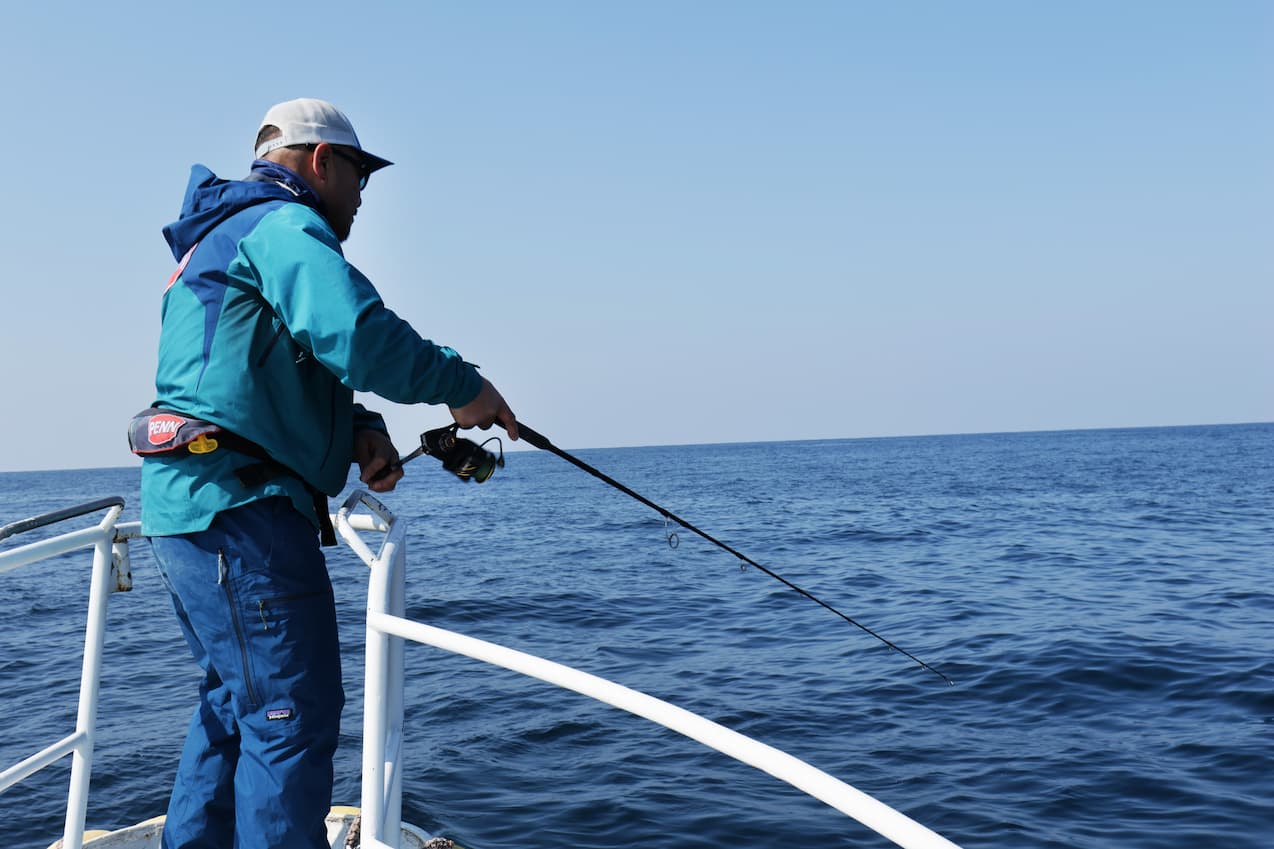
line action explores a wide layer at a constant speed in a one-pitch jerk. The reel handle is constantly rewound while the rod is manipulated to keep the jig moving.
Incidentally, KEI Jig and KEI Jig Sharp were developed to produce the movement of a line that is constantly being moved by winding. KEI Jig is an all-purpose type that widely explores the middle layer when the response is widespread. The KEI Jig Sharp, on the other hand, has a fast fall, making it ideal when the tide is fast, or when there is a broad reaction near the bottom and you want to reach the jig quickly to search for it. Since it can easily produce irregular action, it can also be used to make fish chase it in a narrow layer with a linear action, and then make them react to the fish’s kinetic vision with irregular movements to lead them to prey on it.
KEI Jig explanatory video
KEI Jig detailed homepage
https://www.k-flat.net/?page_id=2319
KEI Jig Sharp explanation video
KEI Jig Sharp detail homepage
https://www.k-flat.net/?page_id=2305
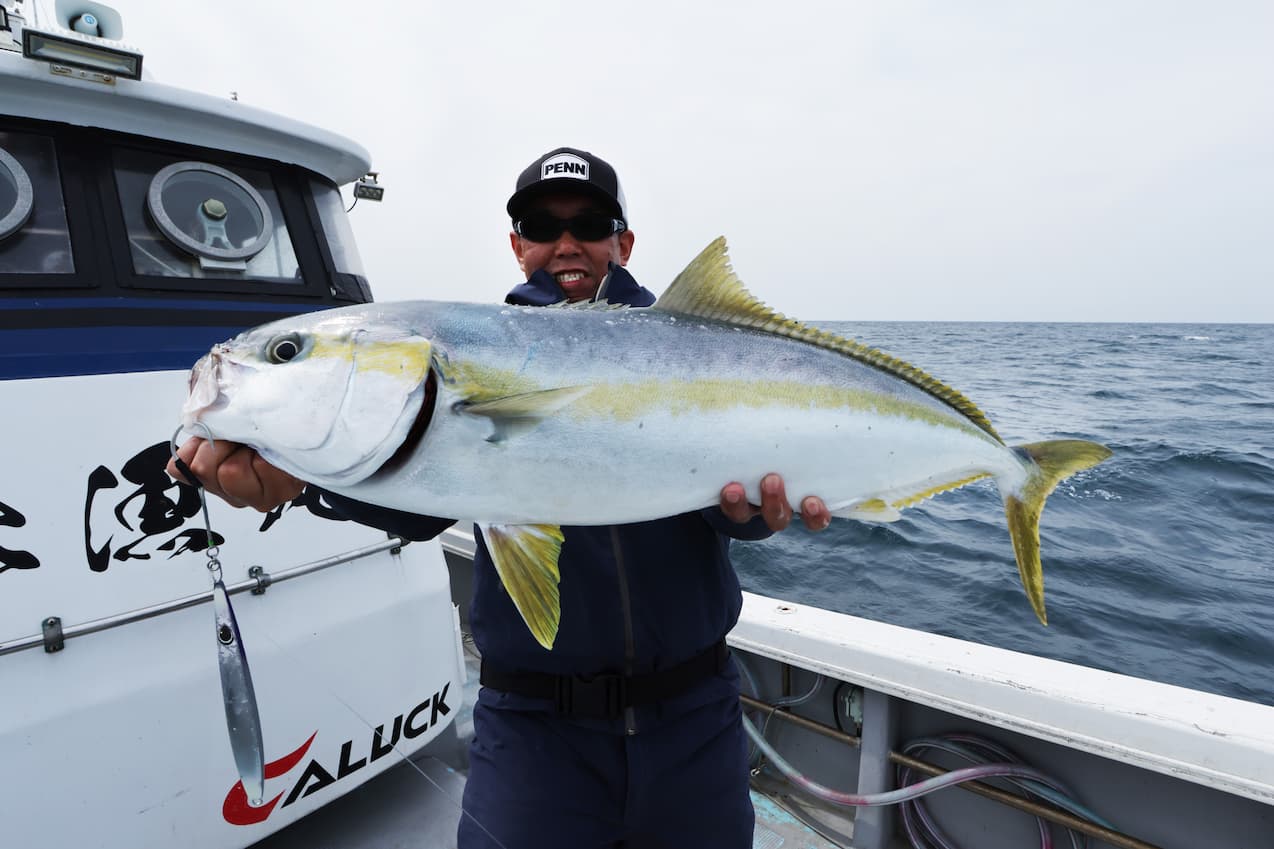
When the tide was a little fast at the time of the interview, Tatsuya Kato, a field advisor for K-FLAT and a tester for Penn reels, immediately selected the KEI Jig Sharp, which has a quick fall and produced results. It is important to observe the situation carefully and respond accordingly,” said Tatsuya Kato, a K-FLAT field advisor and PENN reel tester.
Also, KEI Jig S-cape appeals with the movement of the line of reeling up, but as soon as the reeling up is stopped, it instantly produces a back sliding movement from the tail. When the reeling jig stops moving, it does not flutter and stay, but quickly shifts to a fall action immediately after it goes into a horizontal position. This model was designed with the idea of making chasing yellowtail amberjack react to the speedy fall.
KEI Jig S-cape details website
https://www.k-flat.net/?page_id=2539
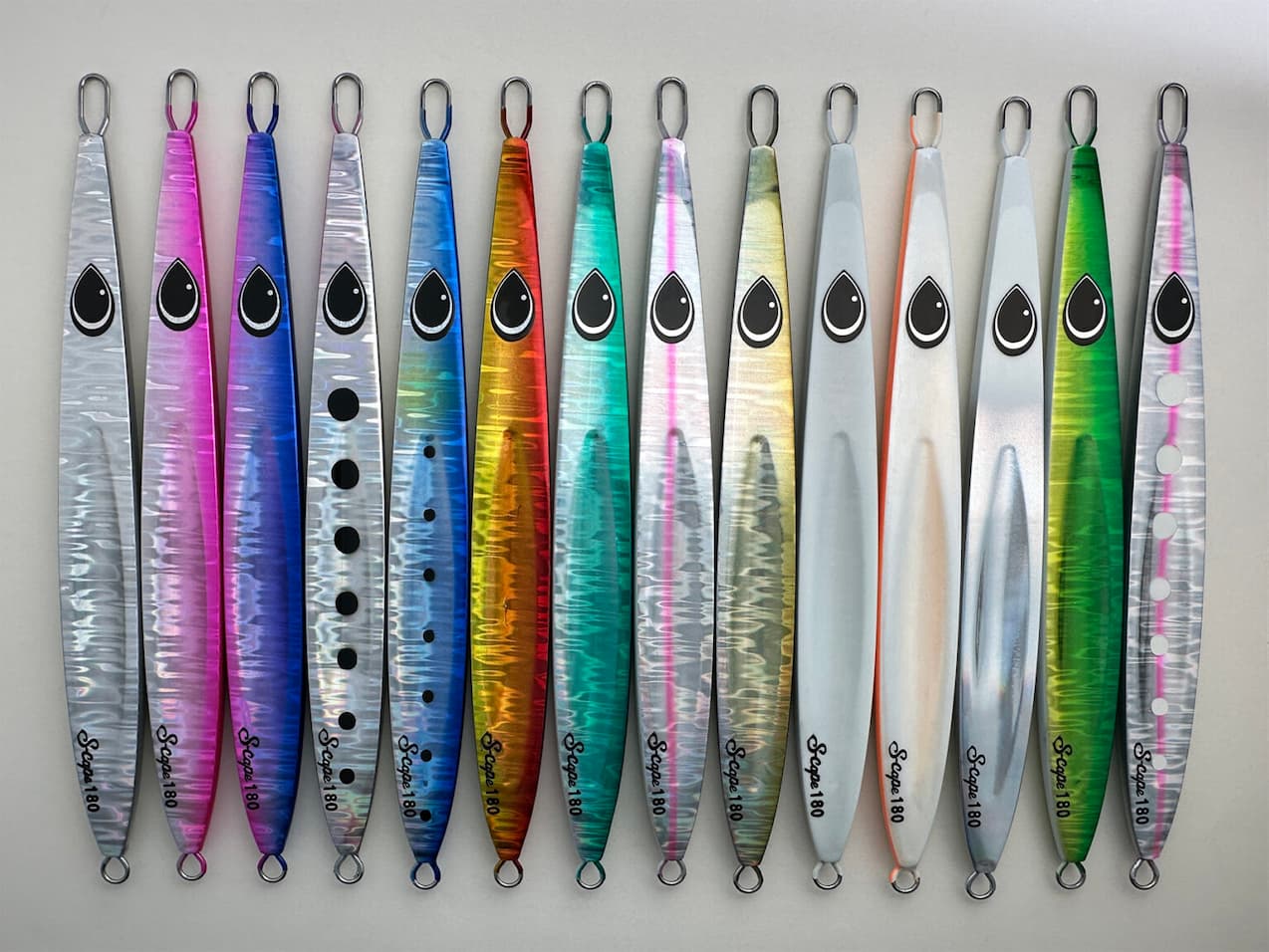
The newly released KEI Jig S-cape was developed to make targeted fish use their mouths with a quick fall. Currently available in 160g, 180g, and 200g, it will also be available in 260g, 220g, and 130g. Incidentally, it is also highly successful for catching cherry salmon!
Point Motion
The point action lures the angler to explore a certain layer of water more carefully, as opposed to the line action, which explores a wider area. It is used to lure fish that are attached to the bottom or near the top of a root, or to attack a pin spot on a fish reef or root. In this case, the jigs used are Gammy and Gammy fat. With these two models, the angler creates a “pause” after jerking, which causes the jig to hover in a horizontal position and then fall from the head side. The angler makes the yellowtail amberjack chase the jig with several actions, and then the jig falls forward at an angle with the head first to create the appearance of the bait escaping. The basic method of using the jig is to move it in several one-pitch jerks, then stop the rod action, or move the rod significantly in the last action to create a motion that stimulates the dynamic vision of the sunfish, followed by a pause in the fall. The Gammy, by the way, is a versatile type that can be manipulated well even in fast tidal conditions or when the boat is being swept fast by the wind. The Gammy fat, on the other hand, has a larger body area, which allows it to produce a hovering action even in weak currents.
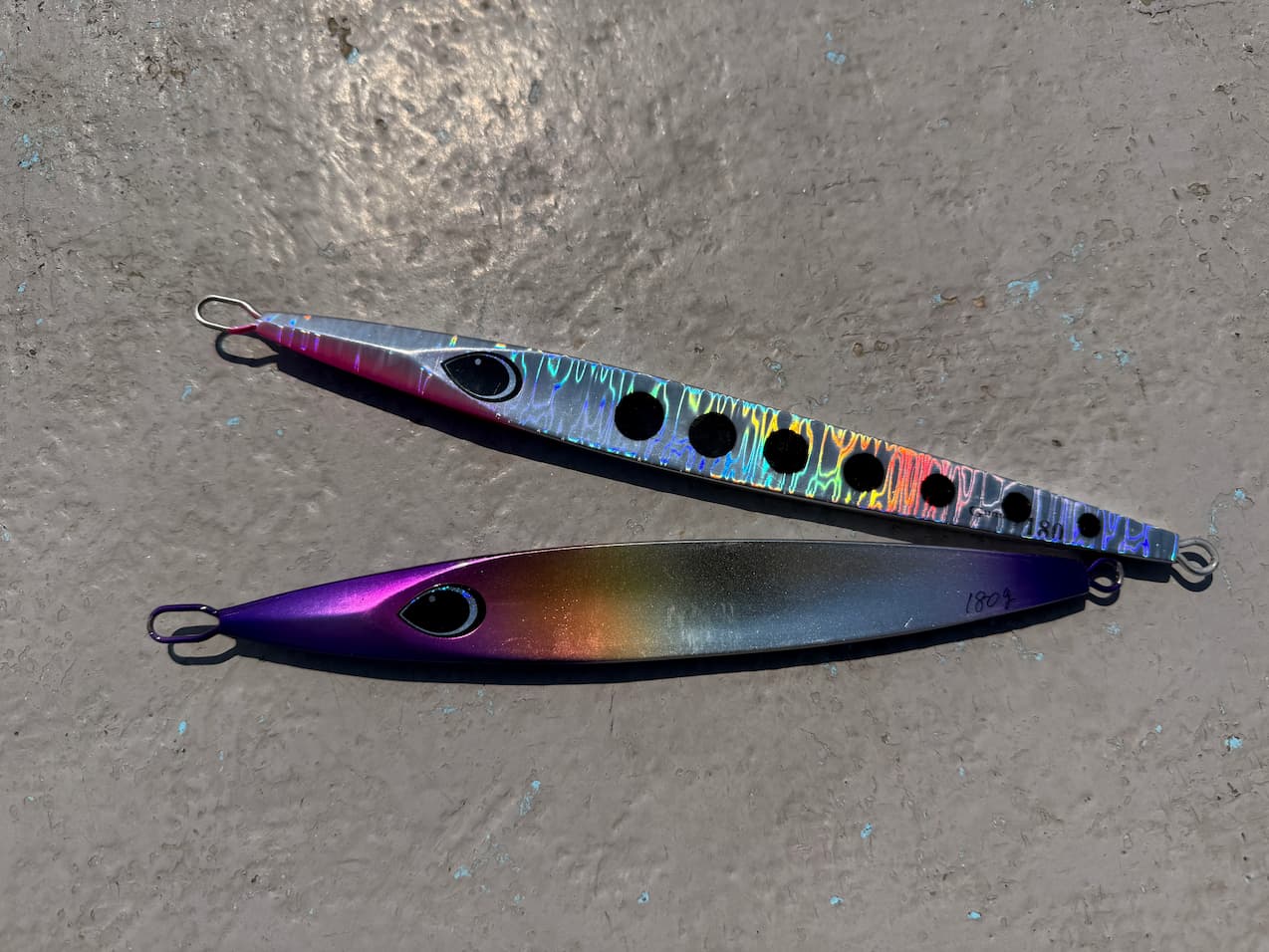
Gammy on top and Gammy fat on the bottom, both have the ability to slide forward from the head after hovering action. The top one is Gammy and the bottom one is Gammy fat.
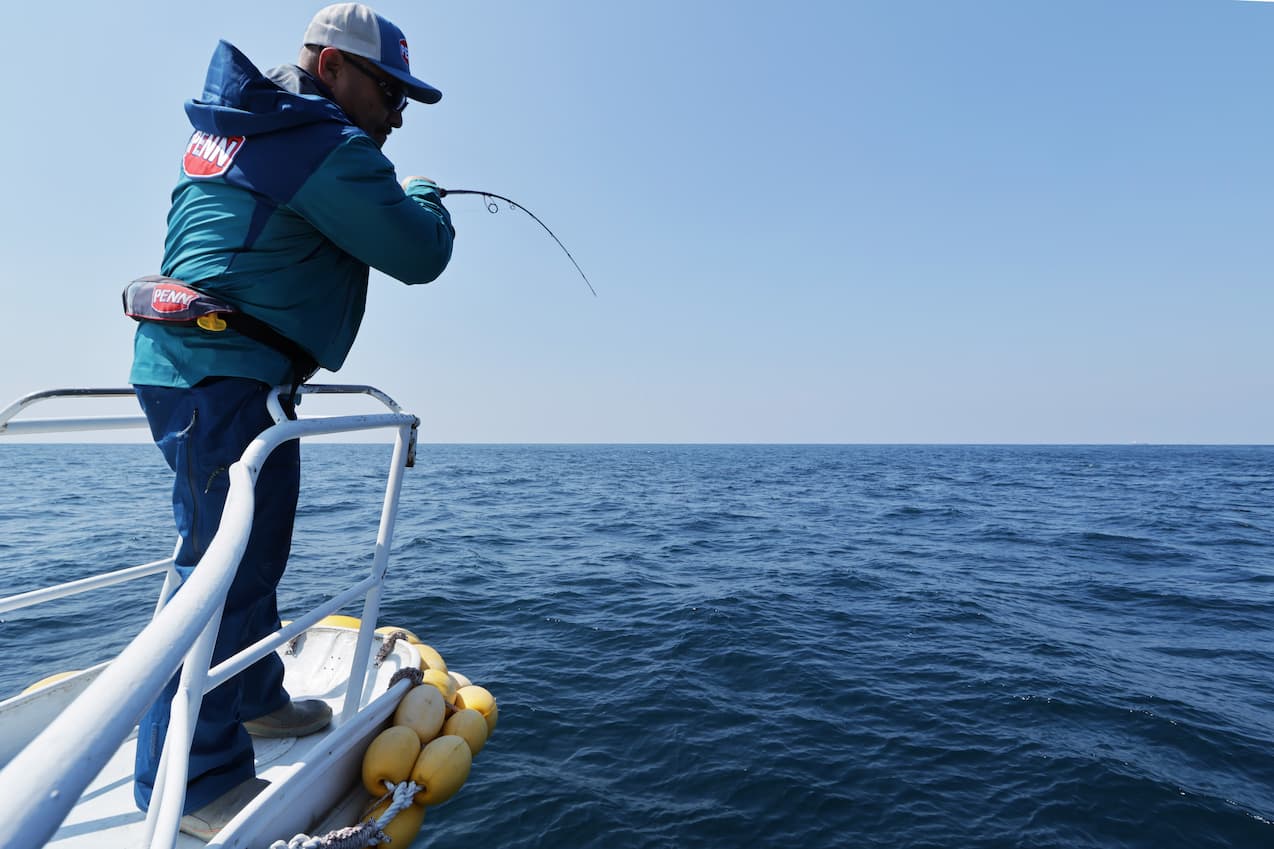
It moves forward just by pausing after jerking, but Hiramatsu also makes a pause after a large jerk. By moving the rod quickly with a large rod action, he can create the effect of a baitfish running away from an approaching yellowtail amberjack with a “poof.
KEI Jig instructional video
Gammy detailed homepage
https://www.k-flat.net/?page_id=711
Gammy fat detailed homepage
https://www.k-flat.net/?page_id=713
Tackle that makes Hiramatsu’s jigging possible
Hiramatsu mainly uses spinning tackle. This is because he casts his jigs to drop them in the target area. Whenever Hiramatsu goes to any area to target sunfish, he first sinks a 200 g Gammy. The line on the reel is PE No. 4. This is because his body remembers the pulling resistance when jerking with this set-up, and by using the same tackle as usual at first, he can observe the tide movement at that point. After that, we select the jig weight according to the tide. If the tide is fast, use a heavier jig. If the tide is slower or shallower, use a lighter jig.
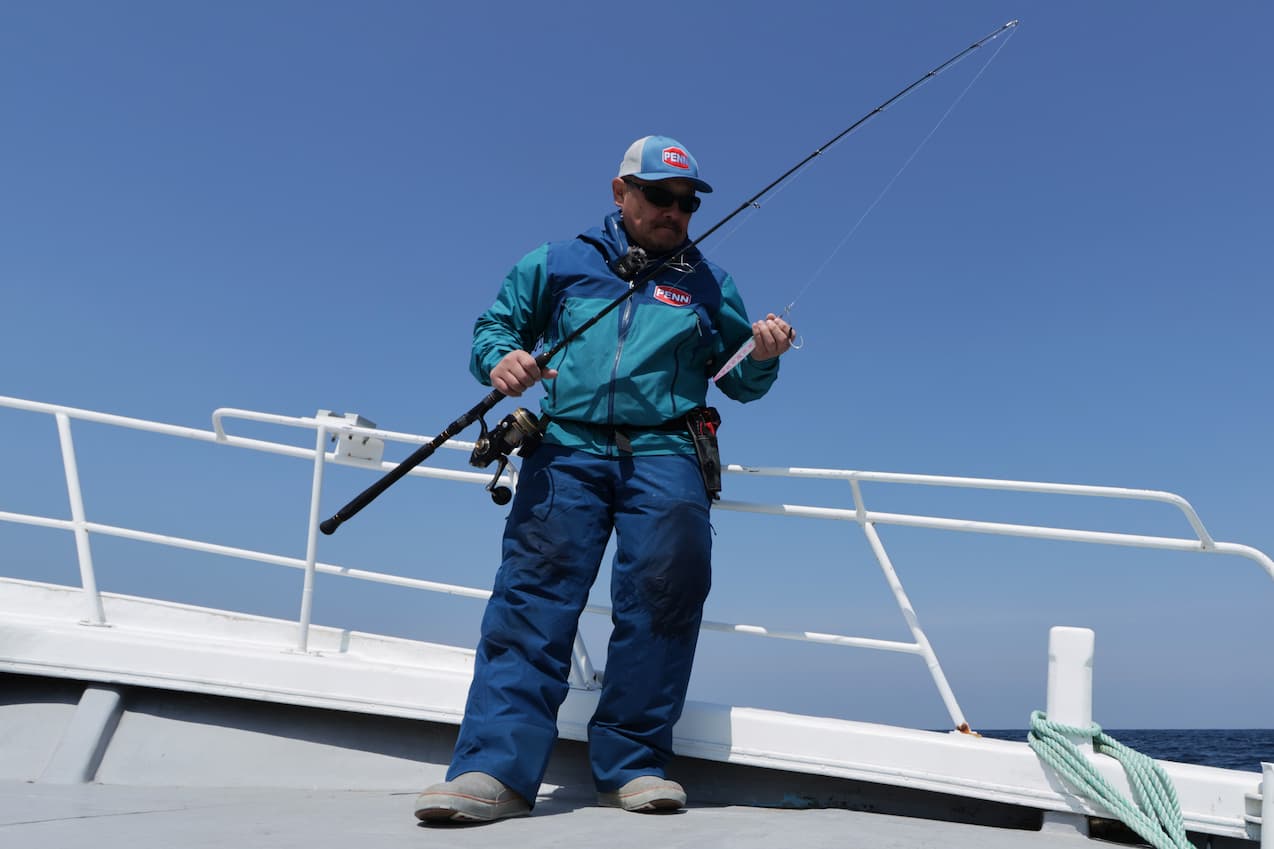
decipher the condition of the current and the boat’s current due to the wind with the tackle you always use. Understanding the situation will lead to the next move.
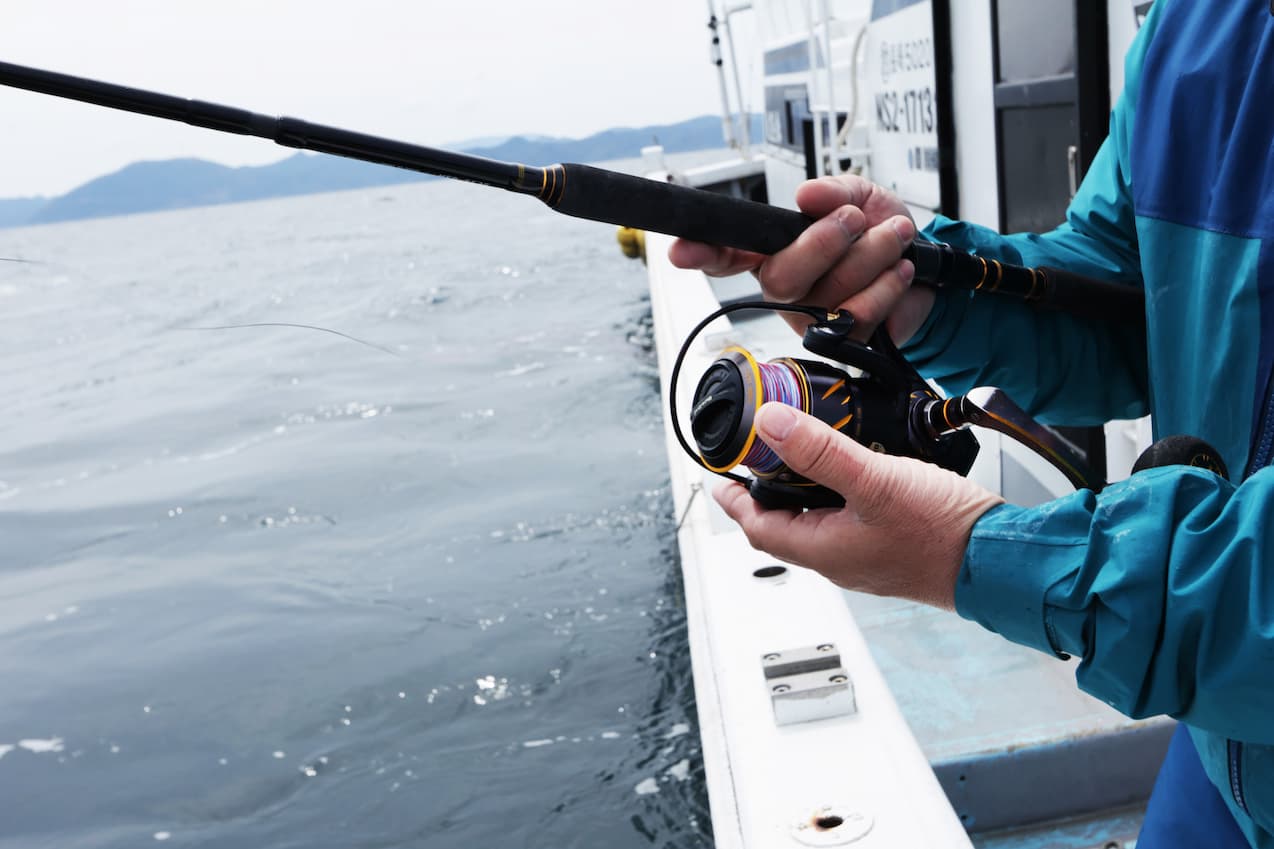
The same line and jig will make a difference in the fall.
Then, read when and where to put in the best spot on the point based on the speed and direction of the boat’s current. Depending on the speed and direction of the tide and wind, you may put the jig under the tide, forward, or backward if you are fishing at the top or bottom of the boat, or you may put the jig in at the right time if you are fishing between the torso. When the jig first reaches the bottom, jerk the jig for the first time to get line slack. The jig is then sunk again, and the second jerk is firmly placed on the point, and the fish is manipulated according to the timing and image of the bite. This is why spinning tackle, which can be cast and has less resistance to line release on the fall, is the main tool.
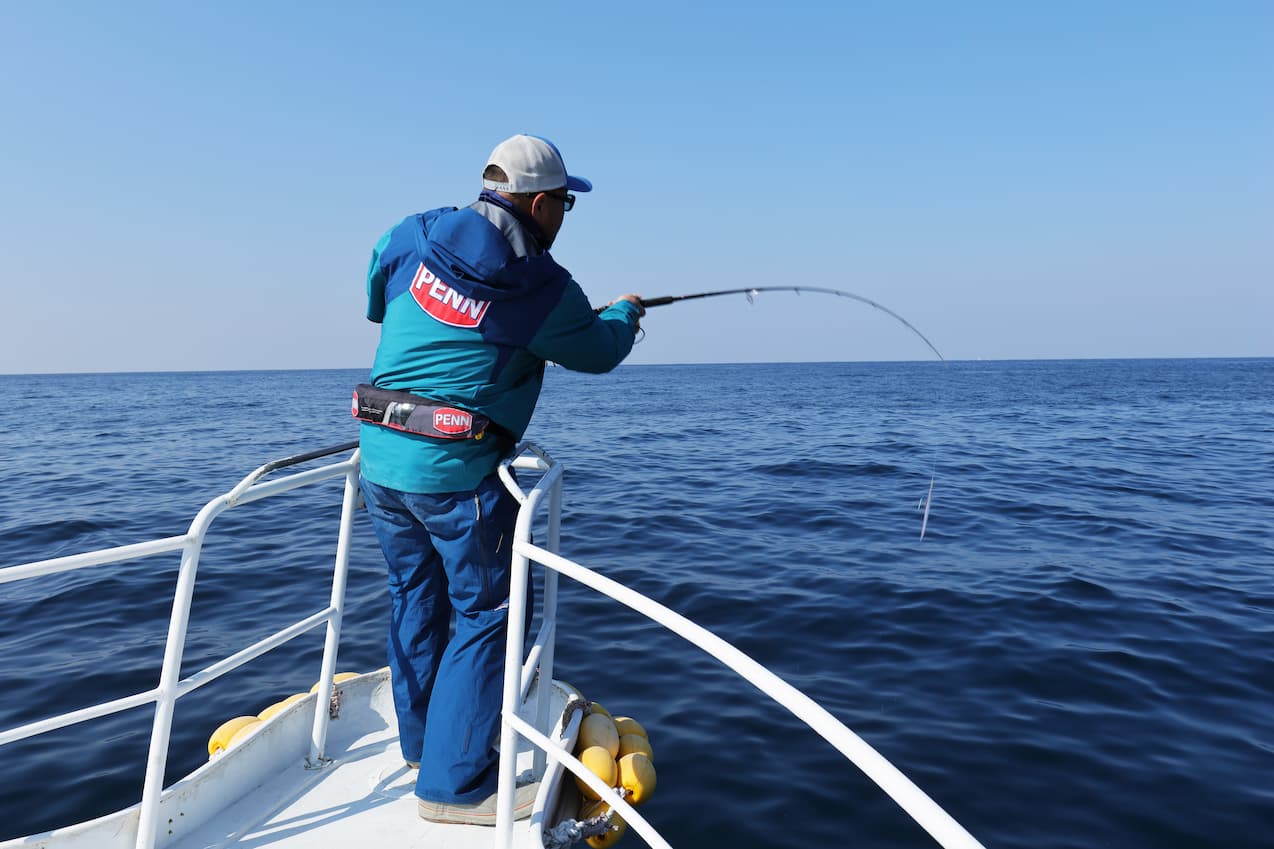
Depending on the tide conditions, we determine the landing position of the jig and timing it so that the jig enters the bottom of the point at the best time. If it is between the body and the bottom, cast and drop the jig. If it is between the body of the fish, the jig weight can be changed as well as the timing of the cast.
Select a rod model that can embody your own fishing style.
In addition, the rod used should be a model with a tone designed for firm action with jigs such as Gammy, Gammy fat, KEI Jig, KEI Jig Sharp, and KEI Jig S-cape. These are the PENN SLAMMER JIGGING 63ML and 63M.
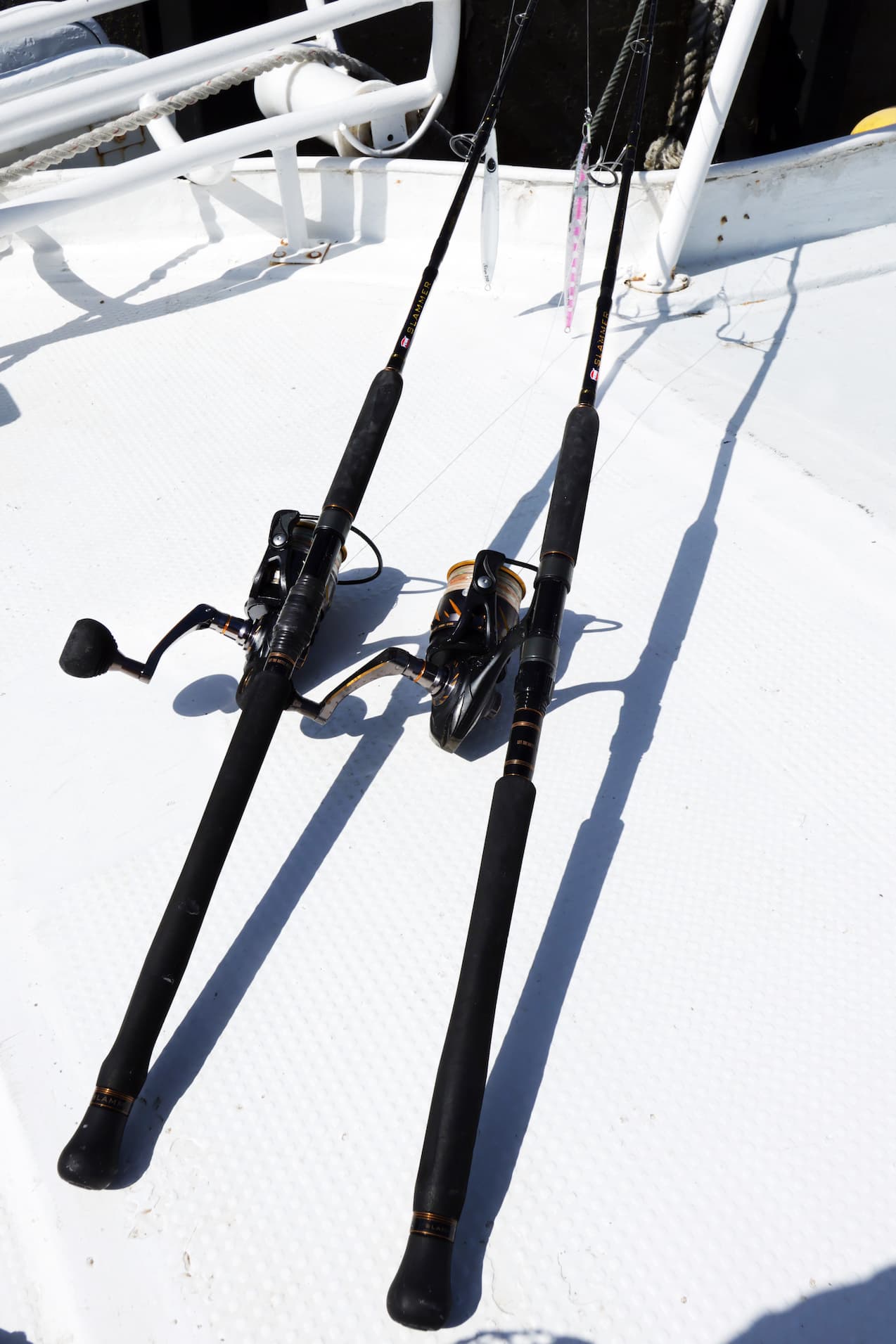
There are various types of jigging rods. For rods that can handle yellowtail amberjack, the most popular these days are those with softer blanks that bend into the body during action, absorbing excess jig movement and smoothing out the action. On the other hand, the opposite performance is also available: a rod blank with a firm body that moves the jig firmly and makes the target react reflexively, while at the same time being highly sensitive. In any case, it is important to select a jigging rod according to what kind of jig to use, how to move it, and how to lead it to a predator.
The PENN SLAMMER JIGGING 63ML and 63M developed by Hiramatsu were designed to facilitate the aforementioned jigging action for targeting sunfish. 63ML has a moderately supple tip to belly section to facilitate the action of luring fish with a point, and is designed to move the jig firmly while controlling the jig’s movement distance. The design allows the jig to move firmly while keeping the distance of the jig under control. The 63ML is not so soft as to absorb the movement of the jig, but has a certain amount of tension to allow the jig to move firmly. On the other hand, the 63M model is designed with a faster taper to make it easier to control the jig with a line movement and to bring even a playful bite to the hooking point. Incidentally, Hiramatsu used to use these two models separately depending on the jig he was using, but recently he has been bringing two sets of 63M tackle on board. In both cases, he uses the same reel and line, with only the jigs set differently. The reason for this is that “by using the same tackle, I can instantly see the underwater tide and other conditions when I change jigs.
PENN Slama jigging details page
https://www.purefishing.jp/product/penn/rod/boat-rod/penn-slammer-jigging.html
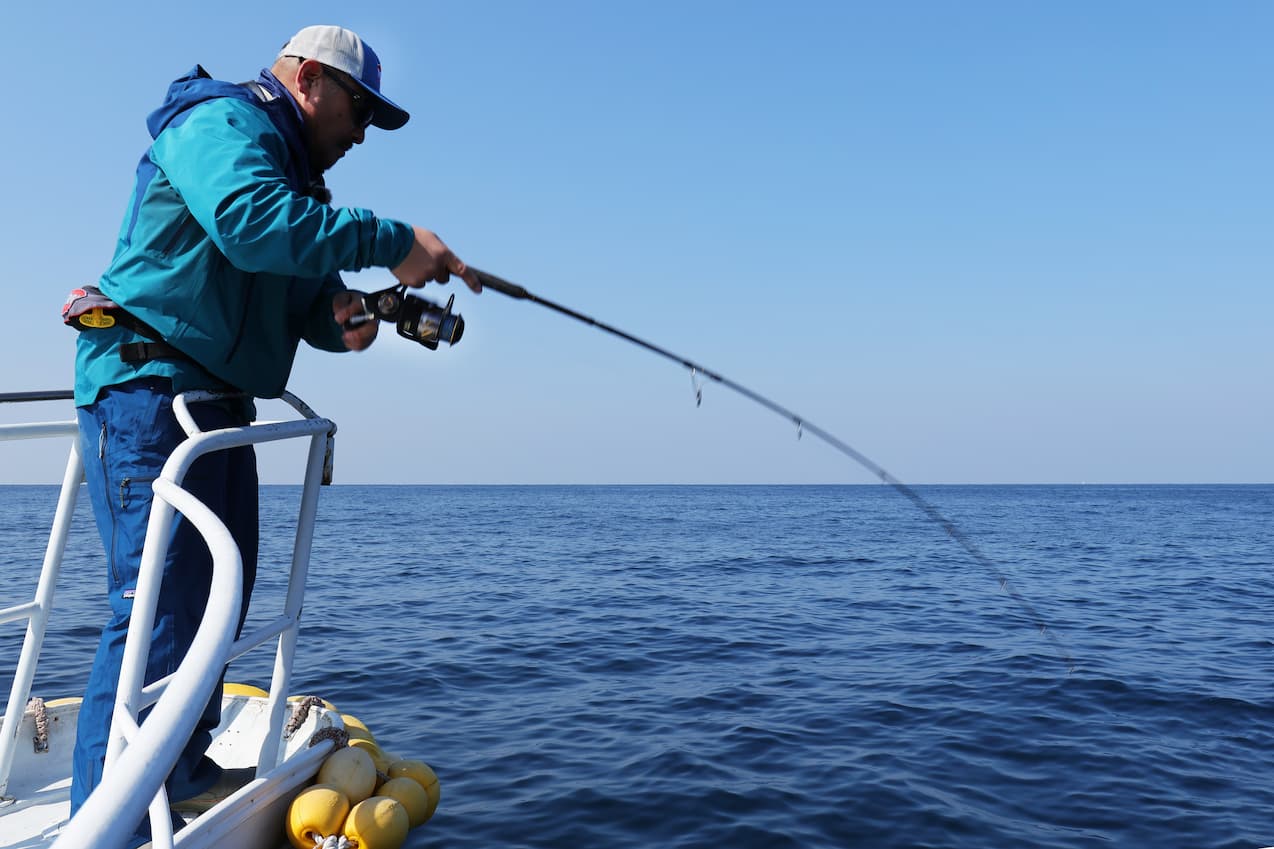
Hiramatsu uses the PENN SLAMMER JIGGING 63M model when targeting yellowtail amberjack. Only the jigs are set differently. With the same tackle, it is easier for him to grasp the situation, such as the state of the tide in the water.
Reel Selection and Reasons
The reel used is the PENN Authority (Authority) No. 6500, which is the flagship model of PENN’s spinning reels. Hiramatsu has overwhelming confidence in this reel. He has two main reasons for this: body rigidity and drag performance. As for the body rigidity, he says that he has been using PENN Authority reels without any maintenance, and they continue to maintain their initial performance without any problems. The waterproof performance is IPX8 grade, and there is no salt contamination. Incidentally, IPX8 waterproof performance is equivalent to flagship models of Japanese reels.
In addition, the drag, which Hiramatsu highly evaluates, is equipped with a shield-type slammer drag. This drag is equipped with PENN’s proprietary DuraDrag with large-diameter washers, which suppresses the drag washers from above and below. It features excellent heat resistance and durability even at strong drag tension. Furthermore, the drag section is shielded and a bearing has been added. The drag part is shielded and a bearing has been added to maintain stable drag force and smooth line release, so anglers can continue to use the lure with peace of mind. Hiramatsu used to use a high-gear model, but now uses a regular gear in his Authority 6500.
The regular model has a gear ratio of 5.2:1, and the maximum take-up per revolution of the handle is 99 cm, which is why I chose this one. This is not because I want to move the jig fast, but because I always want to move the jig firmly while showing it to the fish.”
The regular gear is easier to reel in than the high gear, and allows the angler to keep reeling in the jig while moving it more firmly. At the same time, the reeling torque is stronger and easier to control after the sunfish is hooked.
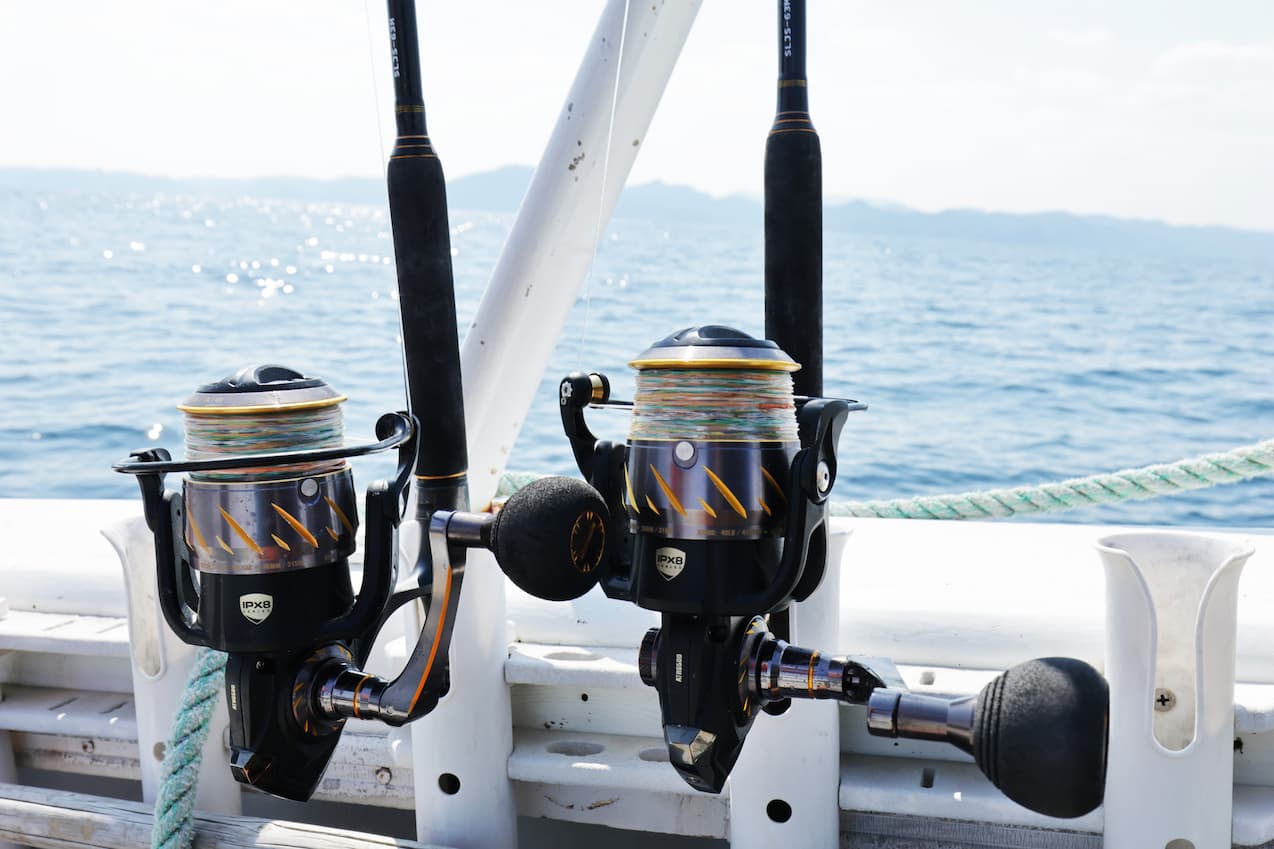
The reel is Authority’s 6500. The reel is 99 cm long at one turn of the handle, which is about 1 m, so it is easy to grasp the situation, such as how many meters from the bottom there is a jig or a hit. 6500 No. 4 PE No. 300 m is just the right size for catching yellowtail amberjack in Tsushima and Genkai Sea.
PENN Authority Explanatory Video
PENN Authority detail page
https://www.purefishing.jp/product/penn/sp/authority.html
Kei Hiramatsu Jerk & Tackle Explanatory Video
How did we catch good-sized yellowtail amberjack?
This time, the reporter accompanied the fisherman for the latter two days of the fishing trip. At this point, Hiramatsu had already caught 20.17 kg. When the reporter accompanied him, he went to the same point where he caught the 20.17 kg fish. The location was a rapids off the west coast of Kami-Tsushima. First, we explored the fish reefs near the rapids, and the captain looked for the right time to enter the rapids. The reason for timing is that this area is tidal, and if it starts to run, it is no good for fishing. Of course, if the tide is stopped, fishing is not expected to be good. The best time to fish is when the tide is running strong. Depending on the tide and wind direction, this is also a place you cannot enter.
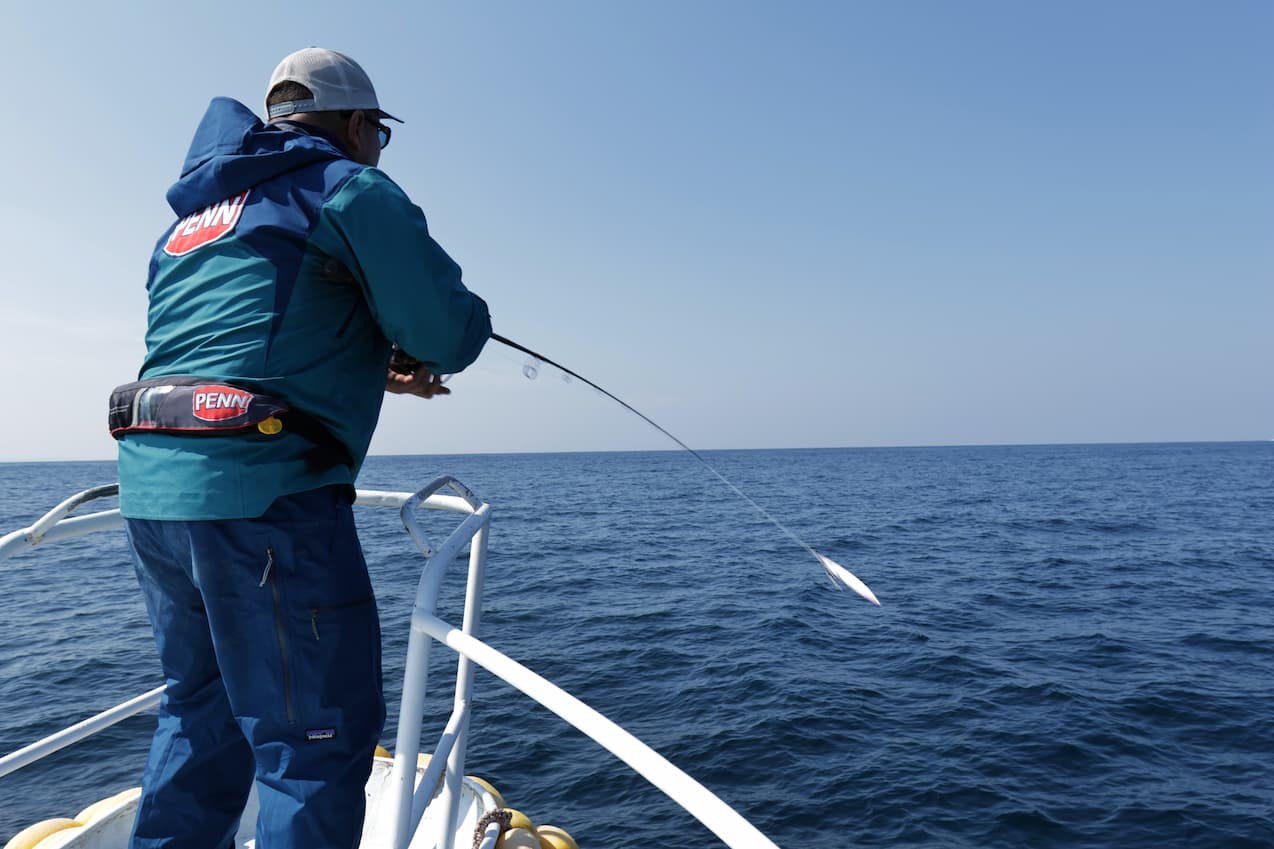
I read the tide and cast a jig and put it in at the right time and distance so that the jig will land on the bottom where the fish are.
Then, after exploring the reef for a while, the captain put the boat on the tide of the rapids. The depth of the water was 135 m, which was deep. Here, Hiramatsu chose the Gummy 220g. The strategy was to make the yellowtail amberjack on the reef discover the jig with a point motion, then make them react to the jig’s dynamic sense by shucking it, and make them bite the jig on the fall. Then, on the captain’s signal, he cast the jig slightly forward on the lower side of the tide. When the jig landed on the bottom, the line entered the front of the boat. Then, after a few moments of one-pitch fishing and getting line slack, I let the jig sink again. At the next landing, the line enters at a slight angle. Watching Hiramatsu manipulate the jig at this timing, I felt that he had a clear view of where the sunfish were landing.
If no bites occur after a few explorations, the boat turns to the upper tide again. Hiramatsu casts the jig in the same way, gets line slack, and then lands it on the bottom again to search. After a few such casts, Hiramatsu muttered to himself as he landed the second time after taking line slack.
This is the time to get a bite,” he muttered.
After landing on the bottom, he made the fish bite by jerking several times and then hovering. Hiramatsu was surprised at this. It’s a good size,” Hiramatsu exclaimed. The fish floated to the surface in a fight typical of Hiramatsu, who did not put strong pressure on the fish with his rod or strong drag value, but instead reeled it in while fighting it off. The captain holding the net shouted, “Big yellowtail amberjack! The fish landed was a magnificent yellowtail amberjack weighing 15.5 kg. It was a typical Hiramatsu catch, as he had read the field and the fish’s movements well.
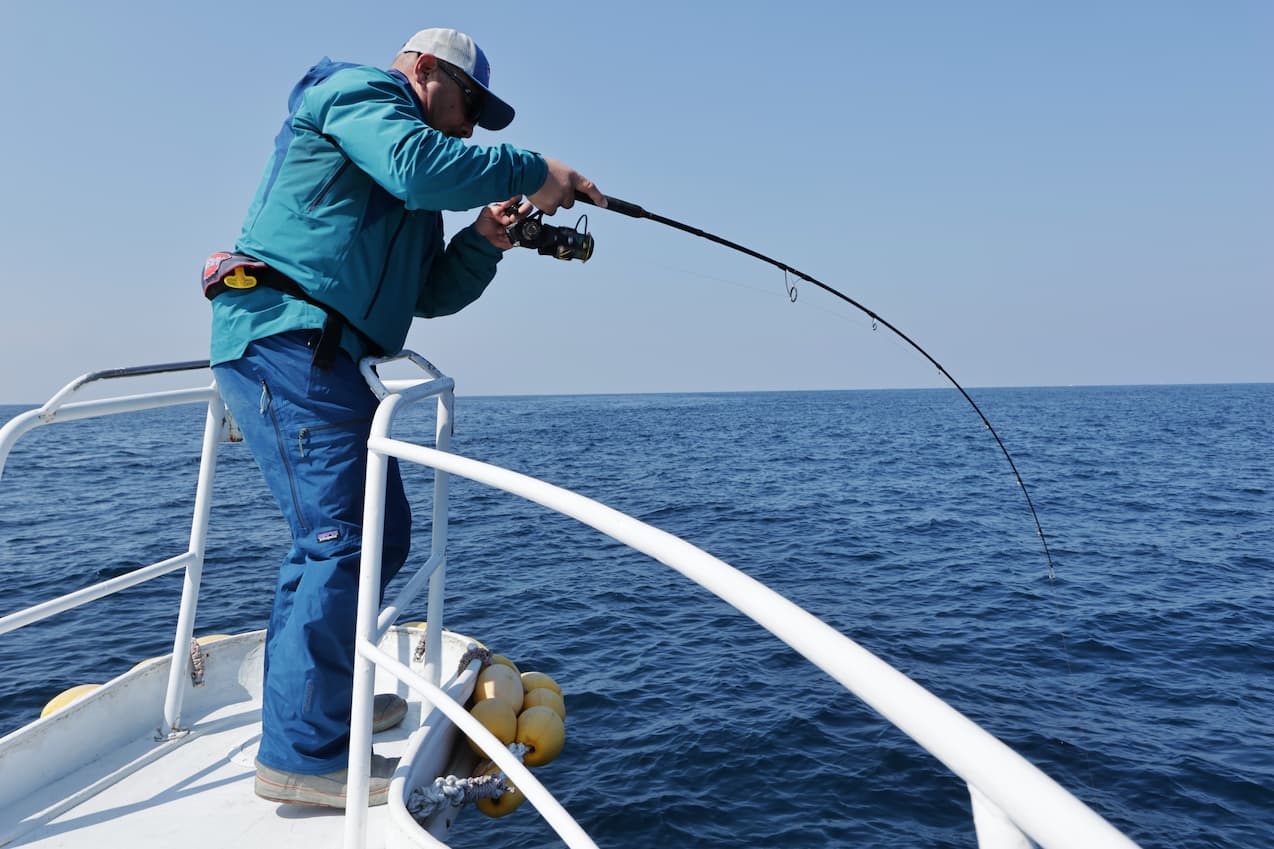
Hiramatsu was able to read the fish and catch it. He kept the drag in action as the sunfish moved, and tried to coax it away from him as he reeled it in to shorten the distance.
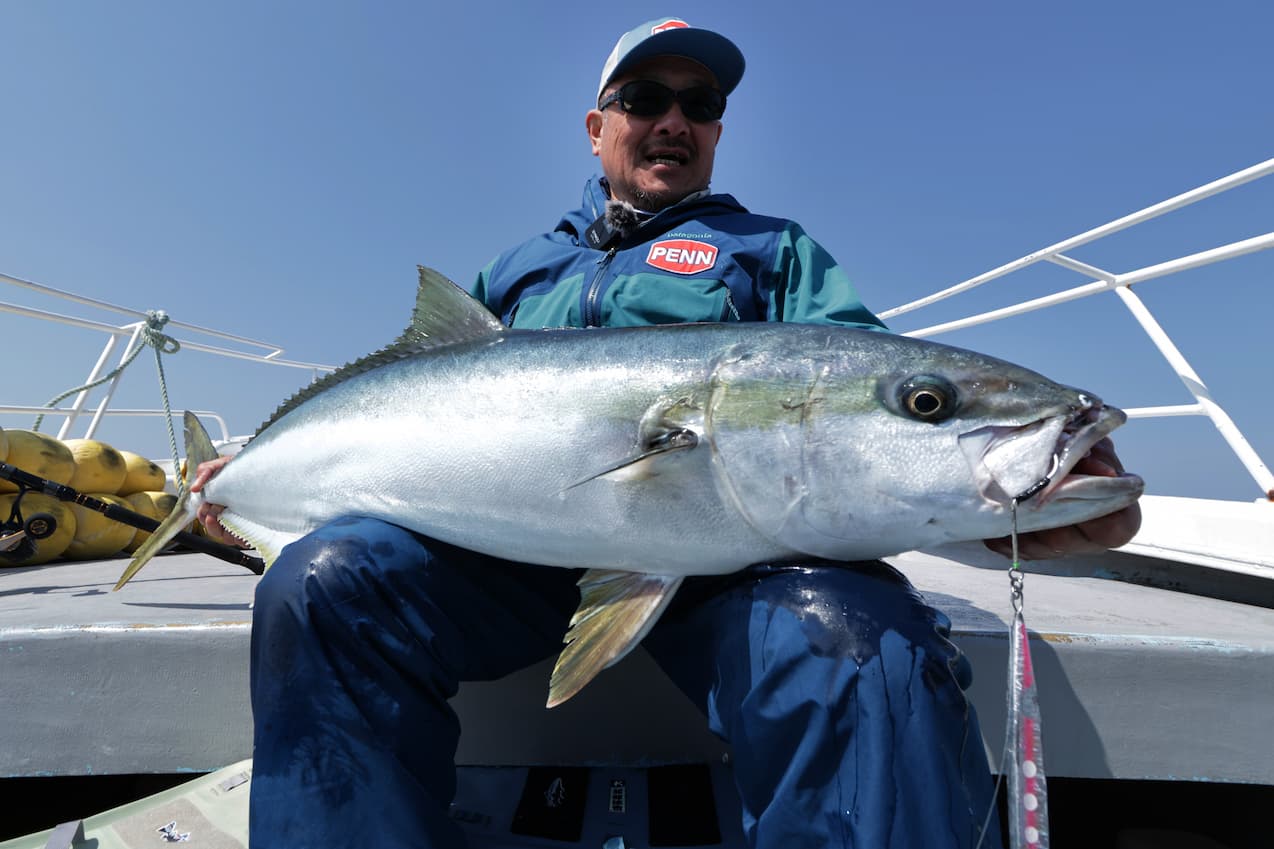
The yellowtail amberjack was caught just as he had hoped. The angler was very satisfied with the catch.
After that, I took pictures while pumping seawater into the yellowtail amberjack’s mouth with a hose, and by the time I was done, the tide had gone so far out that it was impossible to fish.
The next day, we went back to the same spot. This day, no bites came at the same time as the day before. Here Hiramatsu went between the bodies and attached a 280 g Gummy to his bait tackle. Since the tide was beginning to quicken and he had been asked to shoot with bait tackle, he put in a heavier jig and made a firm bottom touch while moving the jig firmly in small increments with a low gear ratio bait reel, perhaps thinking to lure the sunfish that would arrive right on the rapids. And this was also a good guess. Although the size of the fish was not known at the time of the hit and fight, it came up weighing 15 kg. When weighed, it weighed 15.05 kg.
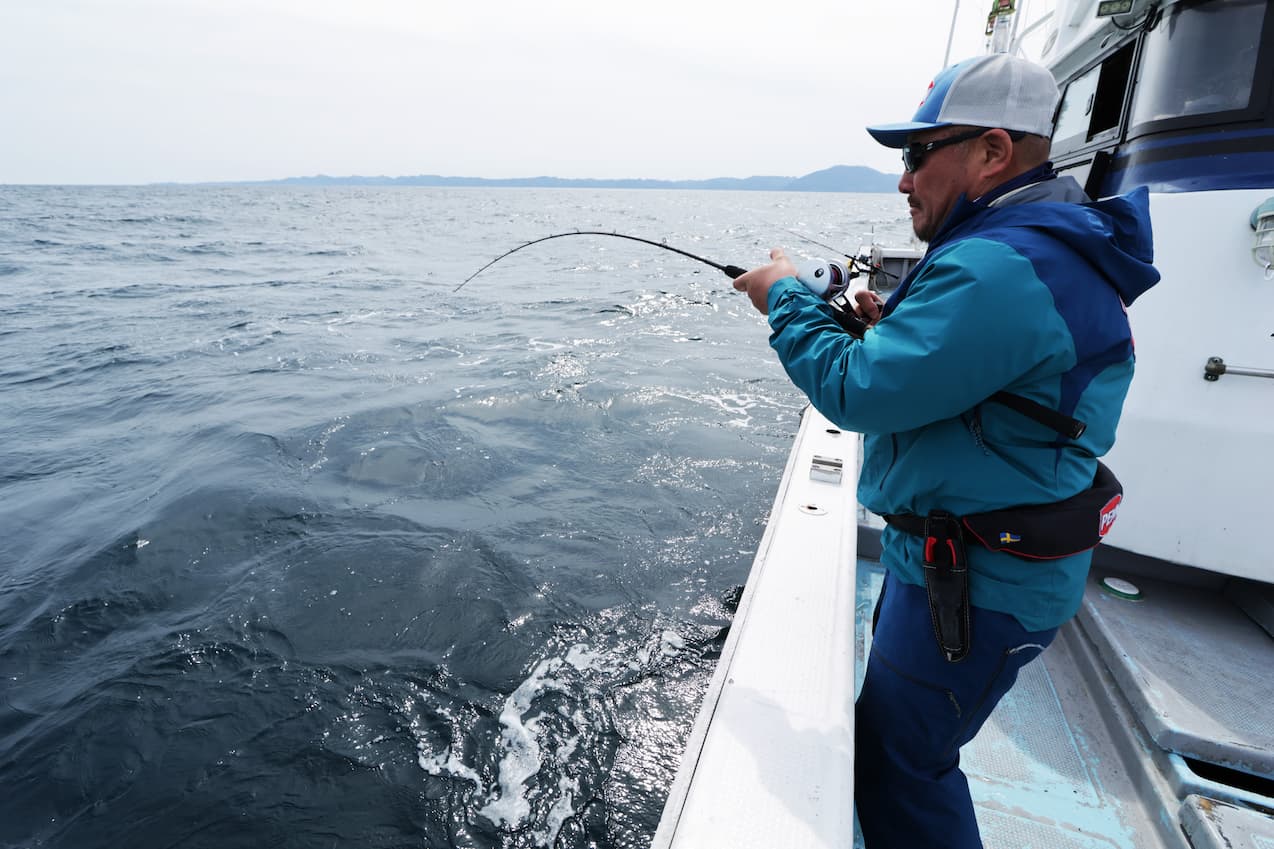

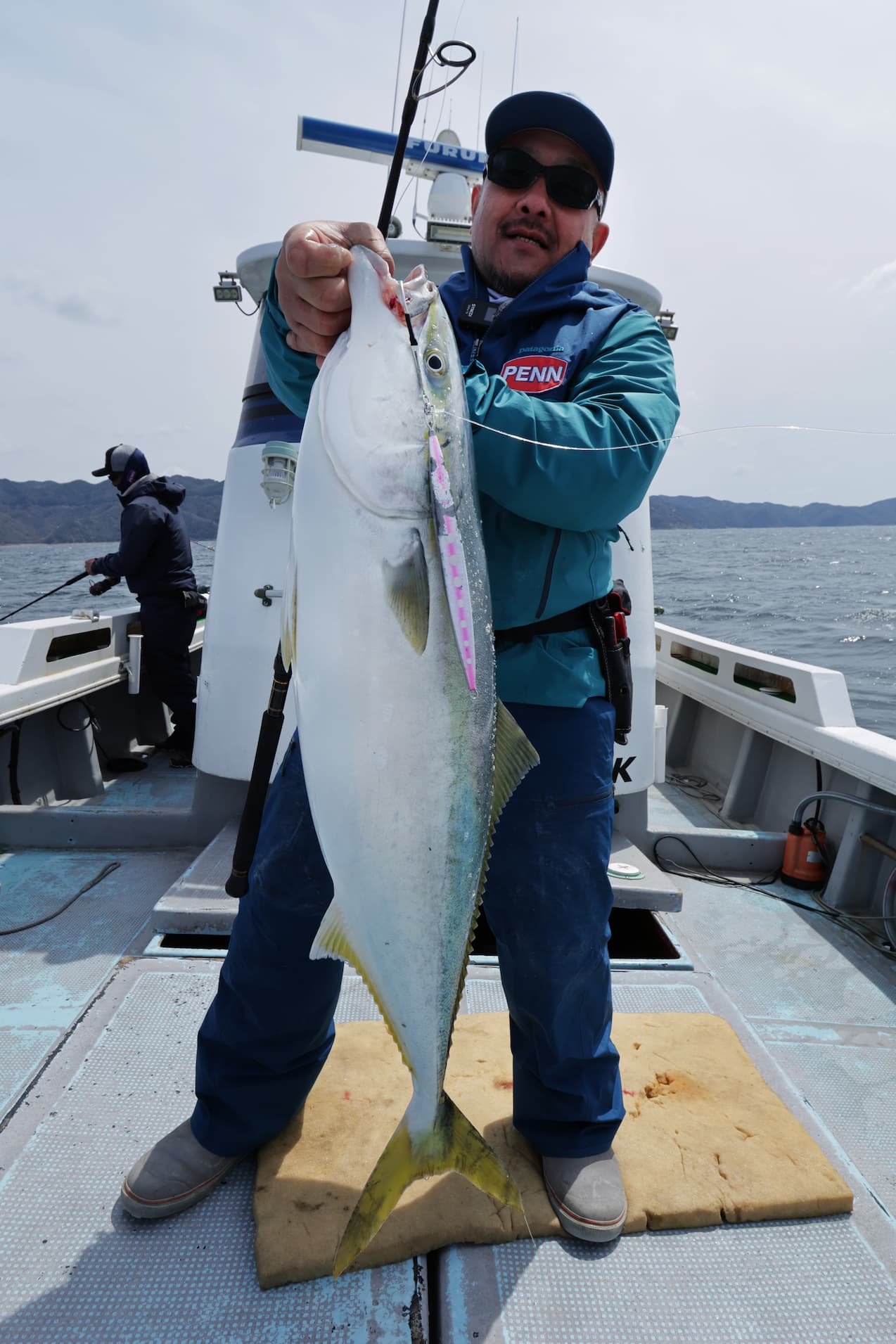
I knew where the good-sized yellowtail amberjack were landing from our previous interactions. When the tide was getting faster, I moved a heavy jig firmly with a bait reel that had a lot of reeling torque, and I caught a good-sized yellowtail amberjack again.
Bait reel used: Fathom 2 Speed
https://www.purefishing.jp/product/penn/fathom-2speed-2.html
As a result, he caught three good-sized yellowtail amberjack by jigging. The captain and the members of the crew were very excited, as was Hiramatsu himself. Moreover, the fish were not caught by just shimmying in the dark, but were caught by reading the fish carefully and aiming at them. The angler’s satisfaction was great. While it is possible to catch a fish by simply jerking, it is difficult to consistently catch fish in this way. It is important to know the fish you are targeting, to know the field, and to develop your techniques accordingly. The best tackle selection is also important in order to execute your own techniques. Jigging in this way will make it a deeper and more enjoyable experience.

In this fishing trip, we hit many yellowtail of good size and proportion. However, targeting these yellowtail at a time when good-sized yellowtail amberjack are being caught will not lead to catching yellowtail amberjack. It is important to focus on the target. The photo was taken during a time when the tide was slow.
Kei Hiramatsu’s Offshore World
https://anglers-time.com/6255/
Tackle inquiries & purchase
Goldic (closed on Tuesdays)
https://www.goldic.net/


